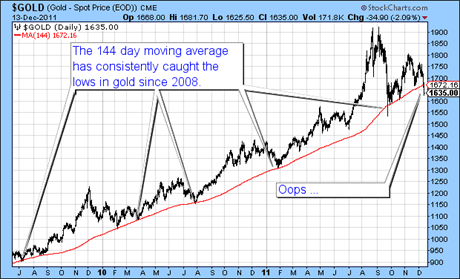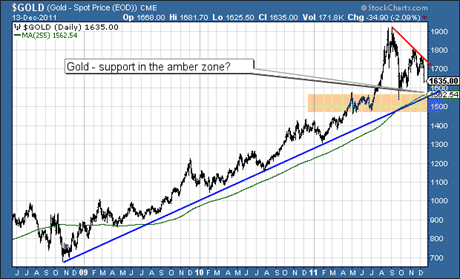Despite all the havoc in the eurozone recently, gold has been having a rough time of it. It fell 3% on Monday, and another 2% yesterday.
And now some are calling the top of the market.
My editor, John Stepek, has just sent me a Bloomberg article featuring US newsletter writer Dennis Gartman, who always seems to get let out when gold has a big sell-off.
MoneyWeek
Subscribe to MoneyWeek today and get your first six magazine issues absolutely FREE

Sign up to Money Morning
Don't miss the latest investment and personal finances news, market analysis, plus money-saving tips with our free twice-daily newsletter
Don't miss the latest investment and personal finances news, market analysis, plus money-saving tips with our free twice-daily newsletter
He declares that "we have the beginnings of a real bear market, and the death of a bull".
So do we?
What were you doing during gold's last bear market?
Well, gold is up about 16% on the year so far. So no bear market there.
This compares with an S&P 500 which is ever so slightly down; a FTSE 100 that's down around 10%; a commodities index that's also down around 10%; a US bond market that's up about 17%; and a US dollar which is ever so slightly up.
If we use the definition that a bear market is a market that is down 20% from its highs, then Gartman may well be right. I don't say it will happen, but there is a very good chance that gold could fall more than 20% from its early September high of $1,920 an ounce.
This would be perfectly normal. Gold has had three 20% corrections since this bull market began in 2001. Once in 2006, again in 2008, and just three months ago in September yes, just three months ago. If you look at intra-day prices, it fell from a high on 6 September of $1,923 to a low on 26 September of $1,535. I make that 20%.
The problem is, when it made that low at about 9.15 am, if I remember rightly I was out walking the dog on Wandsworth Common. I'd just dropped the kids off at school, and now I had my dog ball thrower in one hand, iPhone in the other and was staring at the Kitco App, thinking "ooh, I should buy some silver". (Silver had fallen to $26).
Smartphone technology is wonderful. It makes many things possible. But this wasn't the ideal moment to be implementing these sorts of decisions even if I had previously sold at $1,920, which I hadn't.
By the time the US markets were opening, both gold and silver had already rallied. The former then closed the day above $1,600 and the latter above $30. The bear market was over. I'd pretty much missed it.
What were you doing during gold's last bear market? I was walking the dog.
If trading these market swings is your game, that's all fine and dandy. Myself, I just don't have the time or the mental discipline required for this kind of approach, full time. I have a trading portfolio, which I sometimes play with, yes. But I also have a much larger core holding which I don't touch. I have other things in my life I want to concentrate on.
So, first, I look at the fundamentals for gold. Have these changed? No. If anything they've intensified. I won't go on about them here save to say we are going through a generational monetary unravelling and in such a situation you want to own gold. You may well also need your metaphorical tins, guns and bomb shelters at some stage, but I do not have a buy signal on those just yet.
Then I like to look at a chart.
The 144-day moving average loses its magic
The wonderful 144-day moving average is back in the spotlight. This is the red line on the chart below, marking the average price of the previous 144 days. It has, since the crash lows of 2008, continuously caught the lows in gold. Why 144? Don't know. Ask Leonardo De Pisa. But it has worked brilliantly.
When I began writing this article, we were sitting right on it. I wrote,"these things don't work forever and I've an inkling it's not going to hold this time". Gold promptly fell through it.

For now, technically, the issue with gold is the trend line coming down off the September highs, which I have drawn in red on the chart below. However, coming up underneath and offering support we have the one-year moving average in green and that rising blue trend line.

The trouble with trading
As well as three 20% corrections, gold has had a further four 15% corrections since this bull market began in 2001. If you want to trade them, fine if you can do it. If you want to ride them out also fine. But if you do trade these swings, the risk is that you fail to buy back and you lose your position. Then, all you can do as gold rises is watch and declare that gold is a bubble.
In April-May 2006, gold suddenly launched from around $540 to $730. That was too much, too soon. Gold gave it back pretty quickly by late May, if I recall and spent the next 18 months consolidating and edging higher. It wasn't until October 2007 that we saw new highs.
From July 2007 to March 2008 gold went from $640 to $1,033. That was too much, too soon. By October 2008, it was back at $680. It wasn't until October 2009 that we saw new highs again a full 18 months after the first high.
My take on today's action is that we're seeing a similar pattern repeating. In July of this year, gold set off from $1,500 on a move that saw it $400 higher by September. Again, it was too much, too soon, and now we have the inevitable correction.
We can expect many more months of whipsawing, frustrating, consolidating action. I don't think we'll see new highs for a year or more. If these horrible markets get even more horrible, if fear and panic spread, if liquidity runs dry and nations serially default, we could easily sink to $1,500, to $1,250 - $1,000 even.
But gold could just as easily set off on one of its runs, which always seem to come when you're least expecting it, and hit $3,000 or $5,000.
So hang to your hats, my friends and your gold; trade in and out, if you're good at it don't if you're not. But your physical Don't let anyone near it, least of all yourself. In a few years time, you'll be very glad you didn't.
This article is taken from the free investment email Money Morning. Sign up to Money Morning here .
Our recommended article for today
Seven reasons to buy investment trusts
Most ordinary investors put their money into unit trusts or open-ended funds (OEICs). But the financial insiders go for a different kind of fund: investment trusts. Sandy Cross explains why you should too.
Get the latest financial news, insights and expert analysis from our award-winning MoneyWeek team, to help you understand what really matters when it comes to your finances.
MoneyWeek is written by a team of experienced and award-winning journalists, plus expert columnists. As well as daily digital news and features, MoneyWeek also publishes a weekly magazine, covering investing and personal finance. From share tips, pensions, gold to practical investment tips - we provide a round-up to help you make money and keep it.
-
 Why UK investors are backing British stocks in 2026
Why UK investors are backing British stocks in 2026The UK stock market may be lacking fashionable technology shares but investors are keen to buy British next year
-
 UK inflation live: did inflation fall in November?
UK inflation live: did inflation fall in November?The ONS releases inflation data for November tomorrow (17 December). Has inflation continued its downward trend?

